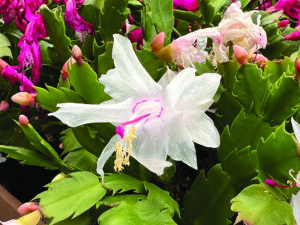
Christmas cacti are very easy to grow and live very long lives, and are often passed on from one generation to another. (Photo courtesy Ginny Rosenkranz)
Christmas cactus blooms in beautiful colors of red, scarlet, pink, purple, orange and white.
They can also bloom in bicolor such as pink and white or red and white or cream and pink.
The Christmas cactus can also be called a “Crab cactus” because the leaf segments have pointed or claw like edges, while a similar plant called the Easter cactus has rounded edges and usually blooms in the springtime.
The plants grow and cascade over the top of the pots, dark green leaf segments attached to other dark green segments in long green lines.
Some segments will produce two segments together, creating a “V” shape and increasing the chances of having even more flowers.
The flowers themselves are tubular with translucent petals that curve upwards.
Most flowers are double or even triple and cascade downwards as well as the foliage, creating a colorful waterfall of green and red, green and pink or green and white.
Christmas cacti are very easy to grow and live very long lives, and are often passed on from one generation to another. They are a forest cactus and in Brazil they live where branches meets the main tree trunk and collects fallen decomposing leaves to make the perfect home for the cactus roots.
In our homes, potting soil is perfect for growing these cacti in containers as long as they have good drainage.
Unlike a lot of tropical plants, Christmas cactus like to be “pot bound” and don’t need to be replanted for many years!
The plants love to live in bright but indirect sunlight or under grow lights all spring and summer and like to be watered lightly every two to three weeks, allowing the soil to dry a bit before watering again. As autumn begins, the plants respond to the number of hours of light, and as with poinsettias, will begin to produce flower buds if they only receive eight hours of light and 16 hours of complete darkness.
This can be accomplished by keeping the Christmas cactus in a bright sunny room that is not used after the sun goes down.
To help the Christmas cactus to bloom, the plants need to be in a room where the temperature is kept around 61-65 degrees in the evenings.
Once the plants begin to form their buds, it is safe to move them into another room where they can be showcased and their lovely flowers can be admired.
(Editor’s Note: Ginny Rosenkranz is a commercial horticulture specialist with the University of Maryland Extension.)



